Sorry, juancho, but sort it all out before you start name-calling.
AFAIK, what you SHOULD have is a crossover like below, with a swap on mid and tweeter polarity if we have come to any sort of conclusion.
But capacitor voltage rating is entirely a matter of taste. A 0.5mH aircoil will scarcely sound different from any other sort of 0.47 coil. Now a 1mH coil in place of a 0.47mH coil might be slightly worrying, but measure it. Wilmslow may simply have unwound a 1mH coil to suit.
Overall I am singularly unimpressed by you guys efforts with this speaker. Big on complaining, short on detail or effort.
A bit controversial, I suppose. But heck, what a lousy boring thread.
System 7 do you know what the 'unsubscribe button' does? Nobody is asking you to stay with this thread. But your snide remarks over the thread eg 'the atc mid unit is hissy and spitty' 'all dome tweeters are spitty" (I'm paraphrasing) are really not helpful and it appears you love just to jump in and make your remarks without actually reading what a poster is saying and even less clarifying any points. The points I made were:
-a cap change to Jantzens cross caps (themselves half the price of Wilmslow ones) has given me the missing bass and a major boost in quality. My speakers now sound sublime and worth every penny invested in them so I have now solved 95% of my problem with more to come with some decent low DCR inductors
-caps should be the same working voltage /type to give equal performance /best imaging
-the inductors are very thin wire /poor quality and are marked with different inductances. I never stated 0.47 to 0.5 was an issue but if their design states 0.47 why not use that value?
-1mh instead of 0.47 is an issue. I didn't bore you with the fact that the value is handwritten on the tape after they have unwound or however they've achieved the value so on the balance of probability it is an error. Dealing with Wilmslow was a litany of Faulty Towers type events that removed any confidence I ever had in them.
I am still using their circuit included in your post. You have never stated on what basis you consider it to be right but FYI it sounds best with all drivers in phase.
As other posters have said, all of this 'boring thread' results from people gettig lousy performance from something that was sold as a fully sorted well designed kit. Whilst I design, build and upgrade valve amps I didn't want to learn the whole new skillset of crossover design /optimisation
So, please peddle off and read some threads you find interesting if you have nothing positive to bring to this one
juancho, time for a review before we get too heated. 
The original complaint from KatieandDad on the speaker was:
Then the active option didn't get anywhere. Bushmeister seems to be doing swimmingly well with that however.
So we are left with crossover and wiring polarity issues for anyone who is still interested in getting the best out of this ATC SM75-150 dome mid design in its various versions. KatieandDad's speaker seemed to have some slope issues in the mid filter, suggesting 0.47mH might work better than 0.9mH to fix a hole around 4kHz. I also suggested that a second order tweeter might work better. This is what Wilmslow did in your version of the speaker. They also threw out that rather uneccessary 100uF capacitor and adjusted the 20uF down to 16uF to compensate. This is the filter with the white background.
Your different speaker (the filter with the brown background) seemed to have a polarity issue between the bass and the mid. The mid to tweeter polarity would be select on test with the different filters and drivers. Very hard to judge by ear and depends on the time alignment. But ++- looked not unreasonable to me.
To your credit, you are now actually rolling your sleeves up and delving. About time. But I'm hard pressed to see how changing a polypropylene capacitor can improve the bass.
Usual images for clarity. Those filters are actually not wildly different. I think the Ditton 66 is an interesting comparison.
The original complaint from KatieandDad on the speaker was:
They just sound dead in the midrange, flat and lacklustre compared to my B&Ws.
Then the active option didn't get anywhere. Bushmeister seems to be doing swimmingly well with that however.
So we are left with crossover and wiring polarity issues for anyone who is still interested in getting the best out of this ATC SM75-150 dome mid design in its various versions. KatieandDad's speaker seemed to have some slope issues in the mid filter, suggesting 0.47mH might work better than 0.9mH to fix a hole around 4kHz. I also suggested that a second order tweeter might work better. This is what Wilmslow did in your version of the speaker. They also threw out that rather uneccessary 100uF capacitor and adjusted the 20uF down to 16uF to compensate. This is the filter with the white background.
Your different speaker (the filter with the brown background) seemed to have a polarity issue between the bass and the mid. The mid to tweeter polarity would be select on test with the different filters and drivers. Very hard to judge by ear and depends on the time alignment. But ++- looked not unreasonable to me.
To your credit, you are now actually rolling your sleeves up and delving. About time. But I'm hard pressed to see how changing a polypropylene capacitor can improve the bass.
Usual images for clarity. Those filters are actually not wildly different. I think the Ditton 66 is an interesting comparison.
Attachments
-
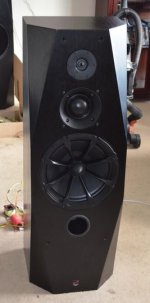 KatieandDad WA Speaker.JPG27 KB · Views: 444
KatieandDad WA Speaker.JPG27 KB · Views: 444 -
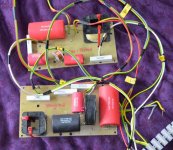 KatieandDad Wilmslow Prestige Crossover.JPG89.9 KB · Views: 446
KatieandDad Wilmslow Prestige Crossover.JPG89.9 KB · Views: 446 -
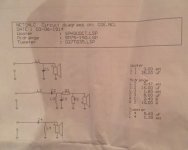 Wilmslow Audio Prestige Monacor Bass.JPG19.2 KB · Views: 438
Wilmslow Audio Prestige Monacor Bass.JPG19.2 KB · Views: 438 -
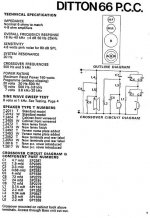 Celestion_Ditton_66_XO.JPG69.3 KB · Views: 434
Celestion_Ditton_66_XO.JPG69.3 KB · Views: 434 -
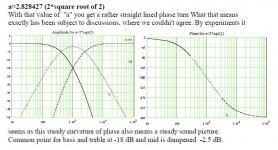 Duelund a=2.83.JPG72.1 KB · Views: 415
Duelund a=2.83.JPG72.1 KB · Views: 415 -
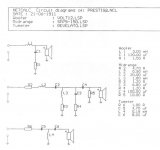 Wilmslow Prestige Circuit.JPG38.6 KB · Views: 163
Wilmslow Prestige Circuit.JPG38.6 KB · Views: 163
Last edited:
Have you started a new thread with details of this minidsp setup anywhere? I would be VERY interested to know the details since it is the way I intend to go.
To be honest I haven't as it is really just a case of looking at the minidsp tutorials and then going through the steps of EQ, time alignment and then playing with crossover slopes.
I could post many, many pictures of before and after driver responses, beautiful crossover nulls, and nice impulse responses, but it is so easy with the minidsp, I didn't really see the point.
Essentially I have a UMIK-1 which using REW, I moved one of the speakers into the middle of a large room, raised them up and did near field measurements of the tweeter and volt mid, which I then gated to give me as accurate a freq response as possible (these matched pretty well with the published ones).
I then used the minidsp software to EQ them flat, well beyond their pass-bands, so I knew I could try shallower and steeper acoustic slopes with some accuracy. I also measured the bass volt drivers in room, at the listening position so I could EQ out the worse room modes and problems - providing a very even bass.
REW does have a rather cool auto EQ function - where it will generate a set of filters for the minidsp automatically directly from the measurements, but I actually found it more accurate and pleasing to do it manually with as few filters as possible - lots of change/measure/change/measure cycles!
Here is an example of an 'in position' speaker response (so lots of reflections!) just to show the reverse nulls with LR24 crossovers at 550 and 3900Hz. Note the scale too - 5dB, so this isn't bad given it is in-room.
I have since improved on this quite a bit with more tinkering.

Last edited:
To your credit, you are now actually rolling your sleeves up and delving. About time. But I'm hard pressed to see how changing a polypropylene capacitor can improve the bass.
I actually changed all the polypropylene capacitors, not just one and mildly tweaked them to alleviate the bass /mid trough. I'm as surprised as anyone else at the all round improvement it's made. It simply underlines the poor quality of the originals.
I'd be interested to know how you control the volume of replay, I assume that is is done in the PC before outputting to the USB? If so, which s/w do you use in the PC?
Is the USB timing controlled by the PC, or by the minidsp?
What do you think of the bass response of the system, it seems to roll off at quite a high frequency for this type of loudspeaker?
Is the USB timing controlled by the PC, or by the minidsp?
What do you think of the bass response of the system, it seems to roll off at quite a high frequency for this type of loudspeaker?
OK.
The minidsp 4x10 HD, has an excellent volume control built into it, which is done in the digital domain. It has remote control so essentially acts as the preamp.
The digital signal is fed into it via a Gustard U12 USB audio converter. This uses an XMOS asynchronous process and is a highly regarded unit for minimizing jitter etc. (if you worry about that sort of thing).
It will feed the minidsp via toslink, spdif or AES (my chosen connection). I run the digital signal into the minidsp as hot as possible taking into consideration the EQing so as not to clip.
Regarding the low end of these speakers, I am very pleased.
I think the sweep I ran on that previous graph started at 50 hz. Here are some more measurements:
Volt mid range dome (VM752) before (red) and after (green) EQ:
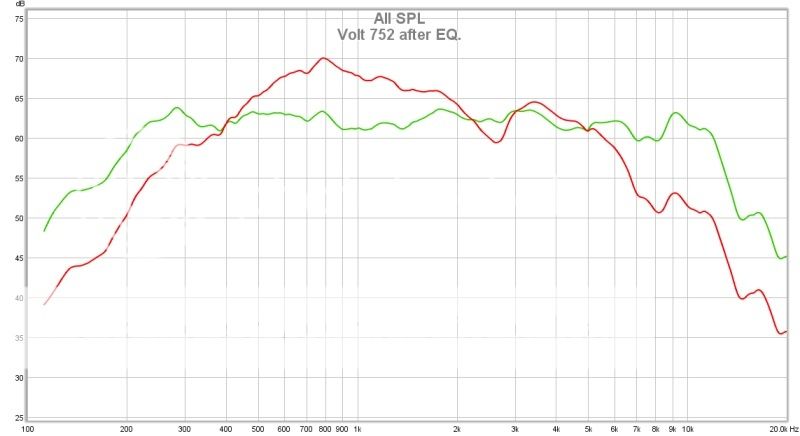
Scanspeak R2904/7000, before (green) and after (red) EQ:
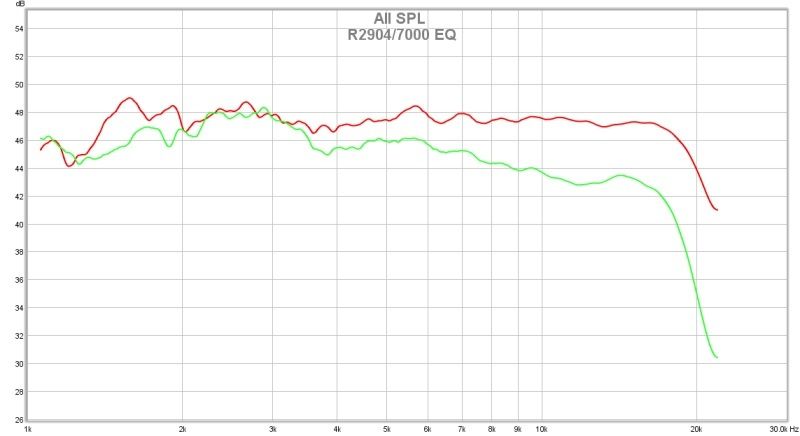
Both speakers at 1M distance in their final resting places in the listening room:

Hope this helps.
The minidsp 4x10 HD, has an excellent volume control built into it, which is done in the digital domain. It has remote control so essentially acts as the preamp.
The digital signal is fed into it via a Gustard U12 USB audio converter. This uses an XMOS asynchronous process and is a highly regarded unit for minimizing jitter etc. (if you worry about that sort of thing).
It will feed the minidsp via toslink, spdif or AES (my chosen connection). I run the digital signal into the minidsp as hot as possible taking into consideration the EQing so as not to clip.
Regarding the low end of these speakers, I am very pleased.
I think the sweep I ran on that previous graph started at 50 hz. Here are some more measurements:
Volt mid range dome (VM752) before (red) and after (green) EQ:

Scanspeak R2904/7000, before (green) and after (red) EQ:

Both speakers at 1M distance in their final resting places in the listening room:

Hope this helps.
That not only helps but answers all my questions from that post thanks very much. The frequency plots look excellent. It seems to me that, at this level, passive crossovers could never do the same job because they can't take the room into account as this method does. I think I must try the same approach. I think the minidsp can handle balanced signals but I didn't see any XLRs on the rear of the photo I saw, how is this implemented (or don't you use balanced leads)? Also, did you buy a complete working minidsp or a bare board?
OK.
The minidsp 4x10 HD, has an excellent volume control built into it, which is done in the digital domain. It has remote control so essentially acts as the preamp.
The digital signal is fed into it via a Gustard U12 USB audio converter. This uses an XMOS asynchronous process and is a highly regarded unit for minimizing jitter etc. (if you worry about that sort of thing).
It will feed the minidsp via toslink, spdif or AES (my chosen connection). I run the digital signal into the minidsp as hot as possible taking into consideration the EQing so as not to clip.
Regarding the low end of these speakers, I am very pleased.
I think the sweep I ran on that previous graph started at 50 hz. Here are some more measurements:
Volt mid range dome (VM752) before (red) and after (green) EQ:

Scanspeak R2904/7000, before (green) and after (red) EQ:

Both speakers at 1M distance in their final resting places in the listening room:

Hope this helps.
I bought the minidsp 4x10 HD, which is a boxed, fully finished package - excellent value for the flexibility and sound quality.
It uses connection blocks for the balanced outputs. So I just cut off my xlr connectors and wired it up. Fairly straight forward.
To be honest I will never go back to analogue active again. The SQ is amazing, even with very high end drivers like these, all my fears about using a digital crossover have been unfounded.
In my last project I spent a long time working on the power supply and op-amps for my analogue active crossover, to get it 'perfect' - optimising everything. But the 4x10 HD is better in every way. The low level detail is incredible.
Perhaps this is because I am feeding it a high quality, low jitter digital signal, so there is only one DAC process, perhaps it is because you can EQ the drivers so well that crossovers become very nearly ideal and digital time alignment all amounts to more positive factors than a digital crossover could ever negatively contribute via the digital processing.
Whatever, I have long been a digital crossover sceptic, but am now a total convert.
It is interesting to me that most of the very high end studio professional products now all include DSP and digital crossovers in their solutions too. I really believe it is the future.
It uses connection blocks for the balanced outputs. So I just cut off my xlr connectors and wired it up. Fairly straight forward.
To be honest I will never go back to analogue active again. The SQ is amazing, even with very high end drivers like these, all my fears about using a digital crossover have been unfounded.
In my last project I spent a long time working on the power supply and op-amps for my analogue active crossover, to get it 'perfect' - optimising everything. But the 4x10 HD is better in every way. The low level detail is incredible.
Perhaps this is because I am feeding it a high quality, low jitter digital signal, so there is only one DAC process, perhaps it is because you can EQ the drivers so well that crossovers become very nearly ideal and digital time alignment all amounts to more positive factors than a digital crossover could ever negatively contribute via the digital processing.
Whatever, I have long been a digital crossover sceptic, but am now a total convert.
It is interesting to me that most of the very high end studio professional products now all include DSP and digital crossovers in their solutions too. I really believe it is the future.
It seems to me that, at this level, passive crossovers could never do the
same job because they can't take the room into account as this method does.
Passive filters work excellent, people just don't have the know-how.
Room modes are a different matter. Modern approach suggests multiple
subs and EQ-ing the rest of, for those that want to minimize the seat to seat
variation in bass response.
Passive filters work excellent, people just don't have the know-how.
Room modes are a different matter. Modern approach suggests multiple
subs and EQ-ing the rest of, for those that want to minimize the seat to seat
variation in bass response.
I agree but my point was that for the vast majority of people it isn't possible to take the room into account with passive crossovers. Even for the people who can do it they would have to spend a lot of time if they moved rooms.
This device doesn't seem to be easily available in the UK, at least I haven't found one yet. Can you say which types of filter characteristics you used in your implementation?
Not having XLRs is a bit of an oversight, is the room limited on the rear panel, or is it just cost-saving do you think?
Can you remind me of which amps you are using?
Not having XLRs is a bit of an oversight, is the room limited on the rear panel, or is it just cost-saving do you think?
Can you remind me of which amps you are using?
I bought the minidsp 4x10 HD, which is a boxed, fully finished package - excellent value for the flexibility and sound quality.
It uses connection blocks for the balanced outputs. So I just cut off my xlr connectors and wired it up. Fairly straight forward.
To be honest I will never go back to analogue active again. The SQ is amazing, even with very high end drivers like these, all my fears about using a digital crossover have been unfounded.
In my last project I spent a long time working on the power supply and op-amps for my analogue active crossover, to get it 'perfect' - optimising everything. But the 4x10 HD is better in every way. The low level detail is incredible.
Perhaps this is because I am feeding it a high quality, low jitter digital signal, so there is only one DAC process, perhaps it is because you can EQ the drivers so well that crossovers become very nearly ideal and digital time alignment all amounts to more positive factors than a digital crossover could ever negatively contribute via the digital processing.
Whatever, I have long been a digital crossover sceptic, but am now a total convert.
It is interesting to me that most of the very high end studio professional products now all include DSP and digital crossovers in their solutions too. I really believe it is the future.
I bought mine from here:
OmnesAudio MiniDSP 4x10 HD | DIY
I am still experimenting with crossovers to be honest. If you EQ the drivers outside of the passbands, you can play with LR, BW, bessel, at 1st, 2nd, 3rd etc right up to 8th order.
So far I like 4th order LR, and 3rd order BW mainly.
I am using MC2 audio professional amps with modified fans - very highly regarded professional audio amplifiers, that run virtually silent with new fans I installed.
Regarding the lack of XLR outputs - I too was hesitant, but it really is very easy to just cut off the xlr connectors and connect them up. They can always be soldered back on at a later date.
OmnesAudio MiniDSP 4x10 HD | DIY
I am still experimenting with crossovers to be honest. If you EQ the drivers outside of the passbands, you can play with LR, BW, bessel, at 1st, 2nd, 3rd etc right up to 8th order.
So far I like 4th order LR, and 3rd order BW mainly.
I am using MC2 audio professional amps with modified fans - very highly regarded professional audio amplifiers, that run virtually silent with new fans I installed.
Regarding the lack of XLR outputs - I too was hesitant, but it really is very easy to just cut off the xlr connectors and connect them up. They can always be soldered back on at a later date.
I agree but my point was that for the vast majority of people it isn't possible to take
the room into account with passive crossovers. Even for the people who can do it they
would have to spend a lot of time if they moved rooms.
I don't think I understand quite well what you mean by it. Let's assume one wants
to build an optimal 3 way (Prestige Platinum) for open space and succeeds.
The speaker as a whole will perform very similar above the transition frequency
in any normal room in the right place (open space) as long as the furniture and
stuff people put in their living space is usual, no matter the room size.
Only bass response dominated by the room modes can vary depending on the
physical room properties. XO filter at 400/3500 Hz has nothing to do with that.
Totally empty space meant for entertainment would need to be treated.
This is true. And why I measured my tweeter and mid in as 'room-free' a method as I could - without going outside or renting an anechoic room!
Very useful for bass room modes as previously mentioned.
In my other set-up, which uses an analogue active crossover, I use multiple subs to get around 'lumpy bass' issues.
Very useful for bass room modes as previously mentioned.
In my other set-up, which uses an analogue active crossover, I use multiple subs to get around 'lumpy bass' issues.
Thanks for the link. Can you also tell me which fan types you use?I'm not so bothered about taking cables apart, it's just the lack of convenience when assembling the system, XLRs are so convenient. Also XLRs extend the shielding.
I bought mine from here:
OmnesAudio MiniDSP 4x10 HD | DIY
I am still experimenting with crossovers to be honest. If you EQ the drivers outside of the passbands, you can play with LR, BW, bessel, at 1st, 2nd, 3rd etc right up to 8th order.
So far I like 4th order LR, and 3rd order BW mainly.
I am using MC2 audio professional amps with modified fans - very highly regarded professional audio amplifiers, that run virtually silent with new fans I installed.
Regarding the lack of XLR outputs - I too was hesitant, but it really is very easy to just cut off the xlr connectors and connect them up. They can always be soldered back on at a later date.
I used four of these - extremely quiet and no probs overheating so far:
Noctua NF-R8 redux-1200: Amazon.co.uk: Computers & Accessories
No concerns with the shielding with XLR connectors removed. I have turned the gain up on the minidsp balanced outputs, which enables me to optimize the gain structure, so there is no hiss at all from the drivers.
Noctua NF-R8 redux-1200: Amazon.co.uk: Computers & Accessories
No concerns with the shielding with XLR connectors removed. I have turned the gain up on the minidsp balanced outputs, which enables me to optimize the gain structure, so there is no hiss at all from the drivers.
I used four of these - extremely quiet and no probs overheating so far:
Noctua NF-R8 redux-1200: Amazon.co.uk: Computers & Accessories
No concerns with the shielding with XLR connectors removed. I have turned the gain up on the minidsp balanced outputs, which enables me to optimize the gain structure, so there is no hiss at all from the drivers.
Thanks for all the info it is much appreciated. Unfortunately I need AC fans for my amps and these all seem to be 12VDC.
FYI Purite Audio sell some of the Mini DSP stuff
Purite Audio | in harmony with truth
They may not advertise, but a quick e-mail will have them supplying one to you ASAP
Stefan
Purite Audio | in harmony with truth
They may not advertise, but a quick e-mail will have them supplying one to you ASAP
Stefan
FYI Purite Audio sell some of the Mini DSP stuff
Purite Audio | in harmony with truth
They may not advertise, but a quick e-mail will have them supplying one to you ASAP
Stefan
Thanks, I did see their website but, as you write, they don't advertise the minidsp.
Thanks, I did see their website but, as you write, they don't advertise the minidsp.
Can you not order directly from MiniDSP in Hong Kong?
miniDSP 4x10 Hd | MiniDSP
They ship to the US with no problems, I can't imagine Great Britain would be an issue.
Bill
- Status
- This old topic is closed. If you want to reopen this topic, contact a moderator using the "Report Post" button.
- Home
- Loudspeakers
- Multi-Way
- Wilmslow Audio - Prestige platinum